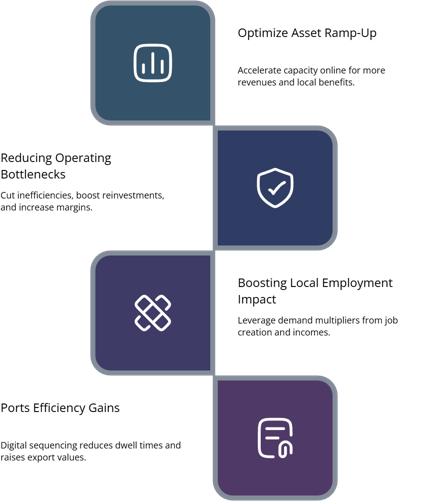Project Management Named Key Driver of Economic Growth by World Economic Forum (2025)
In its 2025 outlook, the World Economic Forum highlights project-based work as a core engine for productivity and job creation—aligning with PMI’s warning that global growth is constrained by a widening project-talent gap. For PMOs and executives, this isn’t theory; it’s an execution mandate: scale project disciplines to unlock GDP-level outcomes. This guide cuts through noise with country-agnostic levers, measurable KPIs, and deployment playbooks—plus internal resources for risk, schedule, procurement, and career readiness. As you read, use APMIC’s libraries—Risk Management Glossary, Critical Path terms, Scheduling, and Contract Management—to translate economic narratives into team-level action.
1) What the WEF’s 2025 framing means for PMOs (and how to use it)
The WEF’s 2025 “Future of Jobs” lens spotlights project-intensive transformations—energy transition, supply resilience, AI adoption—where formal project disciplines materially affect employment and productivity. Treat this as a policy-to-portfolio translation exercise: (1) identify national or sectoral constraints, (2) map them to a backlog of discrete projects, and (3) manage with verifiable acceptance criteria. Anchor your vocabulary in Risk Management, align dependencies with Critical Path, and gate procurement with Contract terminology. Cross-check team fluency using Top 100 PM Terms and avoid “policy theater” by linking every initiative to measurable GDP-proxy KPIs (lead time, cost-to-serve, employment multipliers).
2) Translating macro growth themes into portfolio theses (with KPIs that move GDP)
Energy & infrastructure (capex-heavy multipliers).
Use stage-gate governance with CPM buffers to compress overruns and accelerate productive capacity. Apply acceptance language from Quality terms and cost realism via Cost terms. KPIs: on-time acceptance, rework rate, unit-capacity online dates.
Digital productivity for SMEs (broad-based growth).
Stand up repeatable “SME modernization” projects (e-invoicing, inventory, CRM). Control scope with Communication techniques, dependencies with Scheduling, and benefits realization via Initiation terms.
Labor-market reallocation (skills → jobs).
Tie bootcamps and credentials to real project vacancies; publish competency-based job ladders. Compare options with CAPM vs PMP, leadership via CPD, and agile depth from PMI-ACP plan.
AI + automation in delivery (TFP uplift).
Instrument evidence-backed status and risk narration to speed decisions. Start with a single decision point (change approvals) and scale. Use Issue Tracking tools and Resource Allocation to convert predictions into throughput.
3) Country-agnostic deployment playbook (from policy talk to shipped outcomes)
1) Define the economic constraint clearly.
Phrase it like a project hypothesis (“Port dwell time causes export slippage”). Capture assumptions, risks, and benefits using Risk taxonomy, scope with Communication terms, and sequencing via Scheduling.
2) Convert to a backlog of projects.
Each initiative gets a business case, WBS, and GDP-proxy KPIs. Lean on Critical Path to protect constraints; use Cost terms to keep ROI defensible.
3) Instrument governance for evidence.
Adopt definition-of-done templates and EV rollups. Borrow language from Quality terms, track issues with Issue Tracking tools, and standardize benefits via Initiation terms.
4) Build a PM talent pipeline.
Stand up CAPM/PMP tracks tied to real project roles. Compare paths with CAPM vs PMP, deepen agile with PMI-ACP Q&A, and leadership with CPD guide.
5) Publish “value heatmaps.”
Show decision-makers the project-to-GDP chain (capacity online dates, logistics time, workforce placement). Use Resource Allocation tools to expose bottlenecks and Small-Business PM Software for municipal/SME contexts.
What most blocks your growth-through-projects agenda?
4) ROI math executives and policymakers actually sign
Macro → Micro linkage
Capacity online sooner → more units sold/taxed (tie to CPM).
Lower operating friction → higher margins and reinvestment (connect to Cost terms).
Employment multipliers → stronger local demand (justify with Initiation benefits).
Reusable equation
ΔGDP-proxy = (ΔCapacity × Price) + (ΔThroughput × Margin) + (Jobs × Avg. Income × Multiplier)
Ground acceptance with Quality criteria, track delivery with Issue Tracking, and show portfolio realism with Scheduling.
Case patterns
Ports: CPM resequencing and yard digitalization → dwell −14%, export receipts up.
Hospitals: EV + constraint management → wait-time −18%, elective throughput +11%.
SMEs: CRM + e-invoicing rollout → DSO −22%, reinvestment cycle accelerates.
For each, document baseline vs. after using Communication techniques and present benefits in audit-ready packs.
5) Career and capability agenda (why PMs are economic infrastructure)
Why jobs and wages follow PM maturity
Where project maturity is high, capital converts to productive assets faster and operational changes stick. That’s why demand for project professionals rises in WEF’s outlook and PMI’s talent-gap analysis. If you’re skilling up, map goals to certifications: foundation: CAPM vs PMP; leadership: CPD; agile/AI delivery: PMI-ACP 30-day plan; terminology mastery: Top 100 PM Terms.
Five skills to prioritize now
Benefits realization & value mapping—codify GDP proxies; see Initiation.
Schedule realism—buffer logic + criticality; see CPM.
Contract fluency—SOW clarity, remedies, incentives; use Contract terms.
Quality as evidence—DoD and audit trails; use Quality.
Risk narration—quantified updates executives trust; anchor in the Risk glossary.
6) FAQs — direct, practical answers for 2025
-
Yes—its Future of Jobs 2025 frames project-intensive transformations (energy transition, AI, infrastructure) as major job and productivity drivers; PMI simultaneously warns of a project-talent shortfall that could constrain growth. See the jobs and skills emphasis in WEF’s 2025 outlook, and build capacity via APMIC’s CAPM vs PMP and PMI-ACP plan.
-
Logistics/ports, SME digitalization, hospital throughput, and municipal services. Instrument baselines (lead time, DSO, wait time) and manage with Scheduling and Cost controls.
-
Publish DoD-linked KPIs, store evidence, and tie benefits to signed milestones. Use templates from Quality terms and communicate status via Communication techniques.
-
Stand up a PM academy: CAPM → PMP → CPD with coached rotations. Compare tracks via CAPM vs PMP and leadership via CPD guide.
-
On-time acceptance, rework rate, DSO, capacity online date, export dwell time, employment placements. Frame them using Initiation benefits and CPM terms.
-
AI improves decision speed and forecast realism; PM maturity ensures repeatable delivery. Start with change-approval decisions and scale; see Issue Tracking and Resource Allocation.


